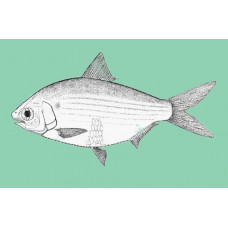Latin name
Anodontostoma selangkat
Other name
Anodontostoma selangkat
Identification
The depth of the body increases with the size of the fish. The second supramaxillary bone is a simple tire. The lower gill rakers range from 100 to 166 mm. The longest gill rakers in the lower part of the arch are smaller than the corresponding gill filaments. The denticles on the posterior margin of the scales are wider than the spaces between them. Biologically probably similar to A. chacunda.
Features of fish fins
Dorsal spines (total): 0; Anal spines: 0; Anal soft rays: 22-28.
Fish colouring
Have a large dark spot behind the gill opening, followed by longitudinal stripes along the flank.
Distribution
Indo-Pacific: Indian Ocean (Andaman Islands), Java Sea, Philippines and further east to the Bismarck Archipelago.
Habitat
Marine tropical brackish pelagic-neritic species. Depth range 0 to 50 m.
Size
Maximum length 18 cm.
Behavior
Occurs near shore. Gathers in large schools to spawn.
Food and feeding habits
They feed on planktonic invertebrates.
Reproduction
A large number of eggs and mollies are released into the water at the same time. Fertilization occurs randomly, without mate selection. Parental care is absent, but due to the large number of eggs, a small proportion of fry survive to sexual maturity.
Fishing
These fish are caught by natural methods, using rods, spinning, nets and so on.
Relationship with a person
Harmless.
| Classification | |
| Phylum | Chordata |
| Class | Actinopterygii |
| Squad | Clupeiformes |
| Family | Dorosomatidae |
| Genus | Anodontostoma |
| Species | A. selangkat |
| Features | |
| Conservation status | Least Concern |
| Habitat | Pelagic |
| Life span, years | No information |
| Maximum body weight, kg | No information |
| Maximum length, cm | 18 |
| Sailing speed, m/s | No information |
| Threat to people | Edible |
| Way of eating | Planktonophage |
Indonesian gizzard shad
Tags: indonesian gizzard shad

